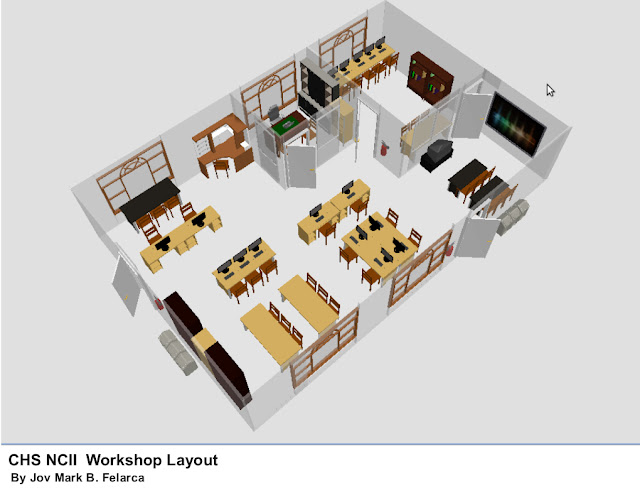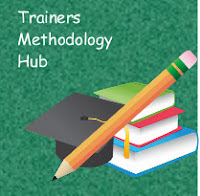In the past tutorial I had covered the development of needed inventory of tools, equipment and materials, its importance and its purpose. For this tutorial I will now cover the desirable workshop layout that a Trainers Methodology Level 1 holder must design to conduct an effective Competency Based Training.
Under Information sheet 1.5-2 of the Plan Training Session - Competency Based Learning Material (PTS-CBLM), Workshop Layout was described as - "In CBT, this is a well organized physical learning environment." Since "a well organized and managed workshop is critical to the acquisition of skills."
Further it states that when planing for a workshop layout, there are three Competency Based Training principles that should be considered, these are:
1. Training materials are directly related to the competency standards and the curriculum.
"Your workshop should more or less mimic the equipment that are in the industry. It should be able to provide for the practice of the trainees on competencies of the job.
Selection of learning resources in CBT is based solely on the competencies of the qualification. Competencies should dictate the learning resources to be laid out, not the other way around. Availability of learning resources should not dictate the competencies to be achieved."
2. Training delivery is individualized and self-paced.
"In CBT, the trainees learn at their own pace. Your workshop layout must provide for this principle.
In conventional training programs it is the trainer who is using the materials as he lectures and demonstrates skills as trainees sit or stand, watch or listen passively. The focus of the layout is providing individuals or small groups with high-quality learning materials that provide for individualized training. The components of the workshops should, therefore, be [layed] laid out in such a way that trainees will be able to use the learning resources individually. A lecture room is not necessary. *
Trainee may not have same training needs even within the same qualification, trainees would be not be working on the same competency.
Trainees should be given sufficient learning time to perform the competency successfully. The workshop should provide for trainees working on the different competencies in one given time."
* Although this can be made acceptable, in my opinion and my experience in teaching TVET makes this improbable and very much impractical, there is still a necessity to use lecture as a method of training specially when dealing with hard to understand terminologies and situation that would require an explanation. Thus a lecture room is still needed or a similar room can be utilized for this purpose. However, this is my own opinion, thus this I leave to the future TVET Trainer themselves to decide.
3. The system allows for learners to enter and exit programs at different times and levels and to receive an award for competencies attained at any point.
"Multiple starting points is allowed in CBT. Depending on the prior learning of the trainee, he may start learning any competency of the qualification. Your workshop layout must allow any trainee to transfer from one competency to another after passing the institutional competency evaluation."
The difference between a conventional shop arrangement and CBT layout was explained and covered in full by the PTS-CBLM on page 241.
Components of a CBT designed facility
The components of a CBT based facility were covered in both Plan Training Session (PTS) and Maintain Training Facility (MTF) Competency Based Learning Materials (CBLM). Although only eight were mentioned in MTF and nine for the PTS. The one that was not covered by the MTF-CBLM was the "Support Service area".
 |
| Figure 1. Sample 3D CBT Workshop Layout |
The Nine CBT Areas
1. Practical Work Area - "This area is where the learner acquires the skills and knowledge components of the competencies prescribed by the standard. This area must be subdivided into work stations, which are arranged in order according to hierarchy of competencies, such as work stations for auto electrical, for engine overhauling, etc."
Based from the description, this is what is commonly known as the Laboratory Facility.
2. Learning Resource Area (Learning Resource Center as per MTF)- "This area is proximate to the heart - the practical work area. This area provides the learner with the knowledge requirements in the various modules responding to the competencies. It is a place where projects can be planned and self-paced learning is based. This area has an array of learning materials in print or soft-copies for a multimedia environment."
Based from the description, this area can correspond to a library.
3. Institutional Assessment Area - "It is located very proximate to the practical work area. This is where recognition of prior learning is done by the trainer. This component also provides the mechanism of assessing the completion of competencies of a trainee. Upon completion of all modules within a competency, the trainee is handed a Certificate of Achievement. This facility is provided with a computer system that houses and manages trainees’ individual records."
In a properly arranged or designed CBT Layout, this can also be the practical work area, in which the workstations' arrangement were designed according to the Core Competency Requirements of a given qualification.
4. Contextual Learning Laboratory - "This facility ensures that the underpinning knowledge, science, mathematics and communication principles as applied to the technology are provided to the learner."
In the above previous comment of mine regarding the a lecture room, based from the given description this can be utilized as an alternative lecture area if properly arranged.
5. Quality Control Area - While the PTS-CBLM simply states that " Various tests aside from metrology and calibration are conducted in this area including in-process quality control." The MTF-CBLM describes this elaborately as "Various tests aside from metrology and calibration are conducted in this area including in-process quality control. Here, finished products generated from the training are scrutinized if standards or requirements are met." While the PTS-CBLM simply states that " Various tests aside from metrology and calibration are conducted in this area including in-process quality control."
6. Trainers Resource Center / Area (Center in PTS, Area in MTF) - "This area houses the learning materials, the training regulations and curriculum exemplars. This is, also, the place where instructors produce courseware or training materials."
Commonly known as Instructor's Office or Faculty Room.
7. Distance Learning Area - the PTS-CBLM describes this as "One major issue of TVET is accessibility. This is the major objective of this component – enhance accessibility of TVET. This is to enable the learning provision outside and away from the training institution in terms of print and non-print media." While the MTF-CBLM further elaborates by adding this "At present, this is implemented in selected qualifications and training centers with Internet connections."
8. Computer Laboratory - PTS States that "This area depicts the major physical change in the delivery – the use of Information Technology. This laboratory has an array of computer units of which learners are provided for them to learn and gain appropriate IT competencies that may include Word, Excel even Desktop Publishing as may be prescribed in the competency standard and curriculum." While MTF adds the following sentences "Computer units are in a LAN environment hooked to an ISP for Internet access."
This can be combined with the Distance Learning Area, since both areas would require computer units and Internet connections.
9. Support Area - "This area provides value-adding competencies as such for Automotive Service Technician NC II, welding competency address underpinning skills in the particular competency."
This area was not covered by the MTF-CBLM but based from the description this can refer to elective competencies that might be added by the Institution in their respective Competency Based Curriculum.
In my next topic I will be covering the recommended layout or possible layout that a trainer can decide upon when designing a Competency Based Training Workshop. If you have further questions feel free to comment bellow.
Cheers!
Related Topics:

THIS IS WHAT i HAVE BEEN LOOKING SINCE I BECOME A TM TRAINEE AT ST CLARE POLYTECHNIC OF BURAUEN LEYTE, THANK YOU SO MUCH. PRESENTLY I AM COMPILING TM POTFOLIO. THANK YOU, THANK YOU AGAIN AND AGAIN YOUR ARTICLES ARE WELL EXPLAINED TO OUR SATISFACTION AS TM TRAINEES NOT LIKE OUR TEACHER WHO IS TALKING LIKE A PARROT.
ReplyDelete